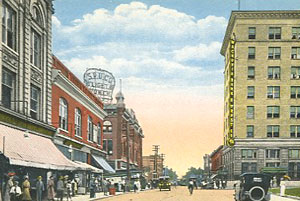|

A timeline of events in Twin City history, complied from Winston-Salem: A History by Frank V. Tursi, and other sources.
1752:
Bishop August Gottlieb Spangenberg leads a Moravian expedition seeking settlement sites, resulting in the purcahse of 100,000 acres centered in present-day Forsyth County. The settlement will eventually be named "Wachovia". 1753:
Bethabara is founded. 1759:
Bethania is founded. 1766:
Construction begins on the town of Salem, its name an Anglicization of "Shalom", the Hebrew word for "peace". 1788-1789:
Segregation comes to Salem. 1802:
The Girls Boarding School, forerunner to Salem Academy, opens. 1828:
The first edition of Blum's Almanac is published. 1834:
Nissen Wagon Works open in Waughtown. 1837:
Salem Manufacturing Company, the first textile mill in Salem, opens. 1849:
Forsyth County is created from the southern part of Stokes County, and a county seat is established a mile north of Salem. 1851:
The new county seat is named "Winston", after Major Joseph Winston, a Revolutionary War hero from Waughtown. 1859:
Winston incorporates.
1873:
The Northwest North Carolina Railroad is extended from Greensboro to Winston, and The Hanes brothers open Winston's first tobacco factory. 1875:
Richard Joshua Reynolds opens his tobacco factory in Winston. 1879:
Wachovia National Bank is open for business.
1884:
West End Graded School, Winton's first public school, opens. 1885:
The Twin-City Daily, forerunner of the original Twin City Sentinel, begins publication.
1890:
Winston's first telephones and electric streetcars go into service. 1892:
Slater Industrial Academy, now Winston-Salem State University, opens. 1897:
The Winston-Salem Journal begins publishing. 1900:
John W. Hanes' Shamrock Mills, forerunner of Hanes Hosiery, opens for business. 1901:
P.H. Hanes Knitting Company is organized. 
1906:
Carnegie Library opens at Third and Cherry in Winston. 1912:
Winston passes a law prohibiting blacks and whites from living on the same street. 1913:
Winston and Salem merge, and Camel Cigarettes and Hanes Underwear make their debut. 1914:
City Hospital, now Forsyth Medical Center, opens. 1917:
Salem Lake is constructed as a city reservoir. 1918:
Worst race riot in Winston-Salem history. 1920:
Winston-Salem is the most populous city in North Carolina, if only for a few years. 
1921:
Hotel Robert E. Lee opens.
1923:
North Carolina Baptist Hospital opens. 1927:
The Winston-Salem Journal and the old Twin City Sentinel merge.
1929:
Reynolds Building and Carolina Theatre open. 1930:
WSJS radio signs on the air. 1932:
Z. Smith Reynolds is shot at Reynolda, the family home. The 1956 movie Written on the Wind fictionalized this event. 1935:
Eastern Airlines begins service to Miller (now Smith Reynolds) Airport. 1937:
The K&W Restaurant (now K&W Cafeteria ) and Krsipy Kreme Doughnuts begin operations.
1938:
Reynolds Memorial Hospital opens to serve black patients. 1939:
Bowman Gray Stadium opens. 1941:
Wake Forest College's medical school moves to Winston-Salem and is named for its benefactor, Bowman Gray, 1948:
Piedmont Airlines, based in Winston-Salem, begins operations. 1950:
Old Salem Inc. is established to save and restore the village of Salem. 1953:
WSJS-TV signs on channel 12. 1955:
Thruway Shopping Center opens. 1956:
Wake Forest University follows its medical school to Winston-Salem.
1958:
The first part of the East-West Expressway (formerly Interstate 40, now US 421) opens. 
1961:
RJ Reynolds opens Whitaker park facility. 1963:
Winston-Salem City and Forsyth County Schools consolidate. 1965:
North Carolina School of the Arts opens. 1966:
Wachovia Building (now Winston Tower) opens. 1971:
Winston-Salem schools are desegregated as crosstown busing begins.
1972:
The Robert E. Lee Hotel is imploded.
1974:
The Winston-Salem Chronicle, serving black residents, begins publication. 1975:
Hanes Mall opens. 1979:
Hanes Corporation is purchased by Sara Lee's parent company. 1983:
Stevens Center for the Performing Arts opens in the old Carolina Theatre. 1985:
R. J. Reynolds buys Nabsico to form RJR Nabisco, and the original Twin City Sentinel ceases publication.
1987:
RJR Nabisco moves its headquarters to Atlanta. 1988:
Kohlberg Kravis Roberts buys RJR Nabisco in the largest leveraged buyout in history. 1992:
Interstate 40 bypass opens, relieving pressure on the East-West Expressway. 1998:
Several of the earliest R. J. Reynolds tobacco factory buildings are destroyed by fire just as they are being converted to condos and offices. 1999:
RJR and Nabisco are split into two companies, returning the RJR headquarters to Winston-Salem.
2006:
Hanesbrands once again becomes a separate company headquartered in Winston-Salem. |